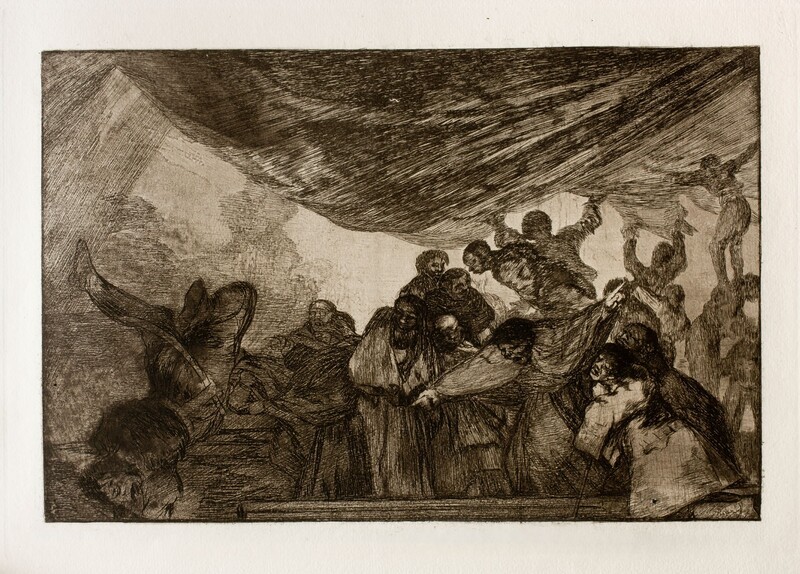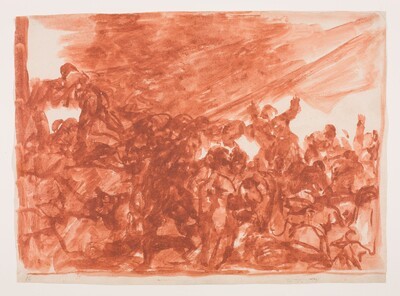- Cronología
- 1815 - 1819
- Dimensiones
- 242 x 356 mm
- Técnica y soporte
- Aguafuerte, aguatinta bruñida y lavis
- Reconocimiento de la autoría de Goya
- Documented work
- Ficha: realización/revisión
- 22 Aug 2021 / 05 Jun 2023
- Inventario
- -
See Femenine folly.
There is a state proof before aquatint in the Albertina Museum, Vienna. The state proof with the burnished aquatint and lavis in the Museum of Fine Arts, Boston, has the number 7 manuscript in the upper right corner, plus Clear folly centred in the lower margin.
A soldier in French uniform falls with a crash into an abyss in the lower left corner of the composition after dismounting from his horse, while two friars look on in horror at the spectacle. On the right, a religious man or preacher, excited, addresses his harangue to two people kneeling on his left. He opens his arms with outstretched index fingers pointing in opposite directions to the light and to the precipice into which the soldier falls. Behind him, men hold a wide curtain in acrobatic poses. A mass of rain falls obliquely from the upper left corner. The stage on which the group of figures is arranged and the awning give the picture a scenographic value that is enhanced by the candle-lighting.
In the state of the Museum of Fine Arts, Boston, the horseman falling into the abyss does not appear. Instead, a beam of lightning or fire emerges from him. Therein may lie the key to the meaning of the print, as the clergyman would point to heaven and hell, salvation and damnation. Goya would make an attack on religious fanaticism and the verbiage of preachers and ecclesiastical orators. In fact, the focus is on the preacher, as his fanaticism deforms his own face and his hands are illuminated. The fact that a French soldier falls into hell is related to the post-war atmosphere. The acrobats have also been seen as an allusion to the liberals, as they would support each other in lifting the veil that shrounds society in darkness and ignorance.
The preparatory drawing for the present print, also entitled Clear folly, is preserved.
-
Etchings by Francosco GoyaJohannesburgoJohannesburgo1974
-
1976
-
Grabados de Goya: colección propiedad de la Biblioteca Nacional, que se conserva en su Gabinete deCasa de la Amistad de MoscúMoscow1979exhibition displayed from January 18th to 31st 1979
-
Goya. Das Zeitalter der Revolucionen. Kunst um 1800 (1980 – 1981)Hamburger KunsthalleHamburg1980cat. 247
-
Goya y el espíritu de la IlustraciónMuseo Nacional del PradoMadrid1988from October 6th to December 18th 1988. Exhibited also at Museum of Fine Arts, Boston, January 18th to March 26th 1989; The Metropolitan Museum of Art, Nueva York, May 9th to July 16th 1989, Madrid curator Manuela B. Mena Marqués, scientific directors Alfonso E. Pérez Sánchez and Eleanor A. Sayre
-
Ydioma universal: Goya en la Biblioteca NacionalBiblioteca NacionalMadrid1996from September 19th to December 15th 1996cat. 307
-
Francisco Goya. Sein leben im spiegel der graphik. Fuendetodos 1746-1828 Bordeaux. 1746-1996Galerie KornfeldBern1996from November 21st 1996 to January 1997
-
Goya. 250 AniversarioMuseo Nacional del PradoMadrid1996consultant editor Juan J. Luna. From March 29th to June 2nd 1996
-
Goya grabadorMuseo del Grabado Español ContemporáneoMarbella1996from March 8th to May 5th 1996
-
Zaragoza1996
-
London1997
-
1999
-
Madrid1999
-
Schlaf der Vernunft. Original radierungen von Francisco de GoyaMunich2000
-
Goya en tiempos de guerraMuseo Nacional del PradoMadrid2008consultant editor Manuela B. Mena Marqués, from April 14th to July 13th 2008cat. 182
-
Bilbao2012
-
Goya luces y sombrasCaixaForumBarcelona2012consultant editors José Manuel Matilla and Manuela B. Marqués. From March 16th to June 24th 2012cat. 77
-
Goya et la modernitéPinacothèque de ParisParís2013from October 11st 2013 to March 16th 2014cat. 215
-
Goya: Order and disorderMuseum of Fine ArtsBoston2014cat. 176
-
Madrid2017
-
OxfordBruno Cassirer1964pp. 397-398, cat. 262
-
Vie et ouvre de Francisco de GoyaParísOffice du livre1970p. 326, cat. 1593
-
Catálogo de las estampas de Goya en la Biblioteca NacionalMadridMinisterio de Educación y Cultura, Biblioteca Nacional1996p. 244, cat. 392
-
MadridReal Academia de Bellas Artes de San Fernando y Calcografía Nacional1996pp. 107 y 111, cat. 15,16 y 35
-
Roma Edizioni de Luca2000pp. 138-139, cat. 47
-
MadridMuseo Nacional y Ediciones El Viso2008pp. 488-489, cat. 182
-
ParísPinacoteca de París2013p. 274
-
Goya: Order & DisorderBostonMuseum of Fine Arts Boston Publications2014pp. 264-265
-
Goya. In the Norton Simon MuseumPasadenaNorton Simon Museum2016pp. 204-211
-
ZaragozaGobierno de Aragón y Fundación Bancaria Ibercaja2017p. 221

